Comprehensive Global STPP Market Analysis 2023
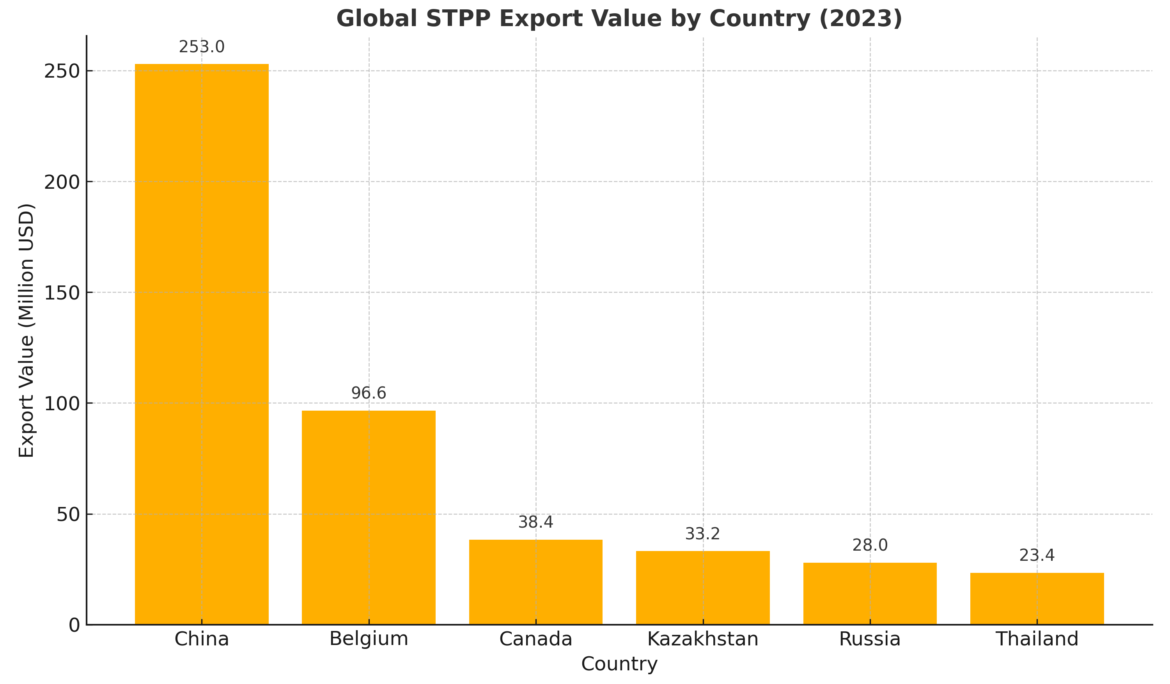
Global STPP Market Analysis 2023: Trends, Prices & Iran’s Outlook
Sodium Triphosphate (STPP) is a key inorganic compound widely used across industries such as detergents, water treatment, ceramics, leather tanning, and paint production. Its water-softening capabilities, pH stabilization, and anti-scaling properties make it an indispensable chemical in both mass manufacturing and niche applications.
This 2023 report explores the global STPP market with a focus on trade volumes, pricing disparities, regional demand patterns, and Iran's positioning within this competitive landscape.
Global Export Landscape
In 2023, global STPP exports exceeded $600 million. China maintained its dominance with over $253 million in export value, capturing more than 42% of global market share. Belgium followed with 16.1%, while Canada, Kazakhstan, Russia, and Thailand contributed to the remaining major shares.
China’s cost efficiency and vertically integrated supply chain have allowed it to lead global pricing strategies, particularly in price-sensitive regions. Meanwhile, countries like Kazakhstan, with much higher unit prices, indicate specialized use cases or low-volume, high-margin trade patterns.
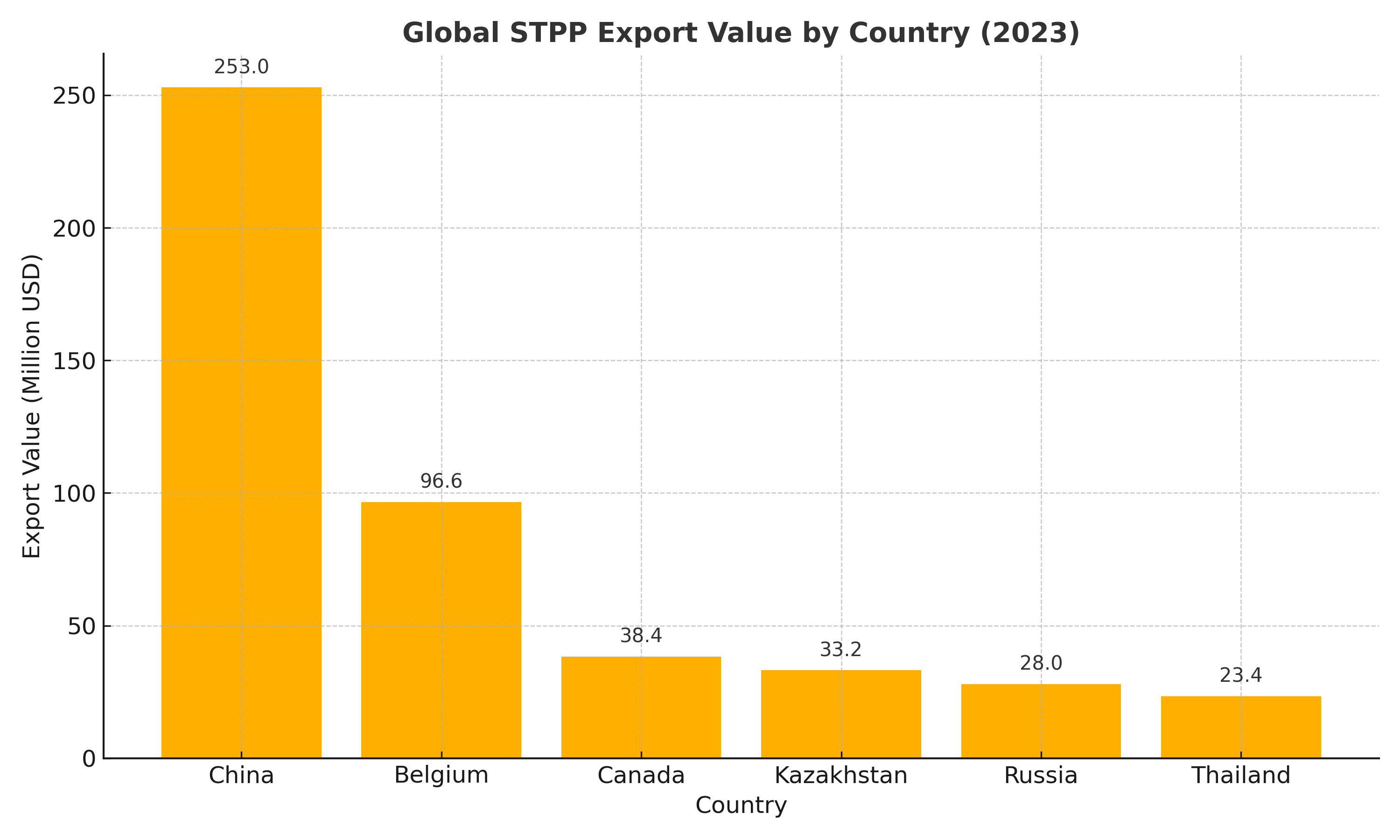
While Belgium and Canada serve niche segments, Kazakhstan’s significantly high unit price—around $3778/ton—suggests either specialized applications or low export volume with high-margin trades. Russia’s export value of $28 million highlights its regional influence, particularly within Central Asia and Eastern Europe.
Unit Price Disparity Among Exporters
Export unit prices for STPP vary significantly across countries. China, maintaining a low average of $1205 per ton, continues to dominate price-sensitive markets through high-volume exports. This pricing strategy aligns with its vast production scale and integrated supply chain.
In contrast, Kazakhstan charges over $3778 per ton, more than triple the Chinese average. Such a high price likely indicates either internal production challenges, small-batch specialized exports, or custom applications commanding premium margins.
This sharp pricing disparity reveals both threats and opportunities. Countries with access to raw materials and close proximity to end markets—especially in the Middle East—can strategically position themselves between the extremes, offering mid-range pricing with consistent quality and faster delivery.
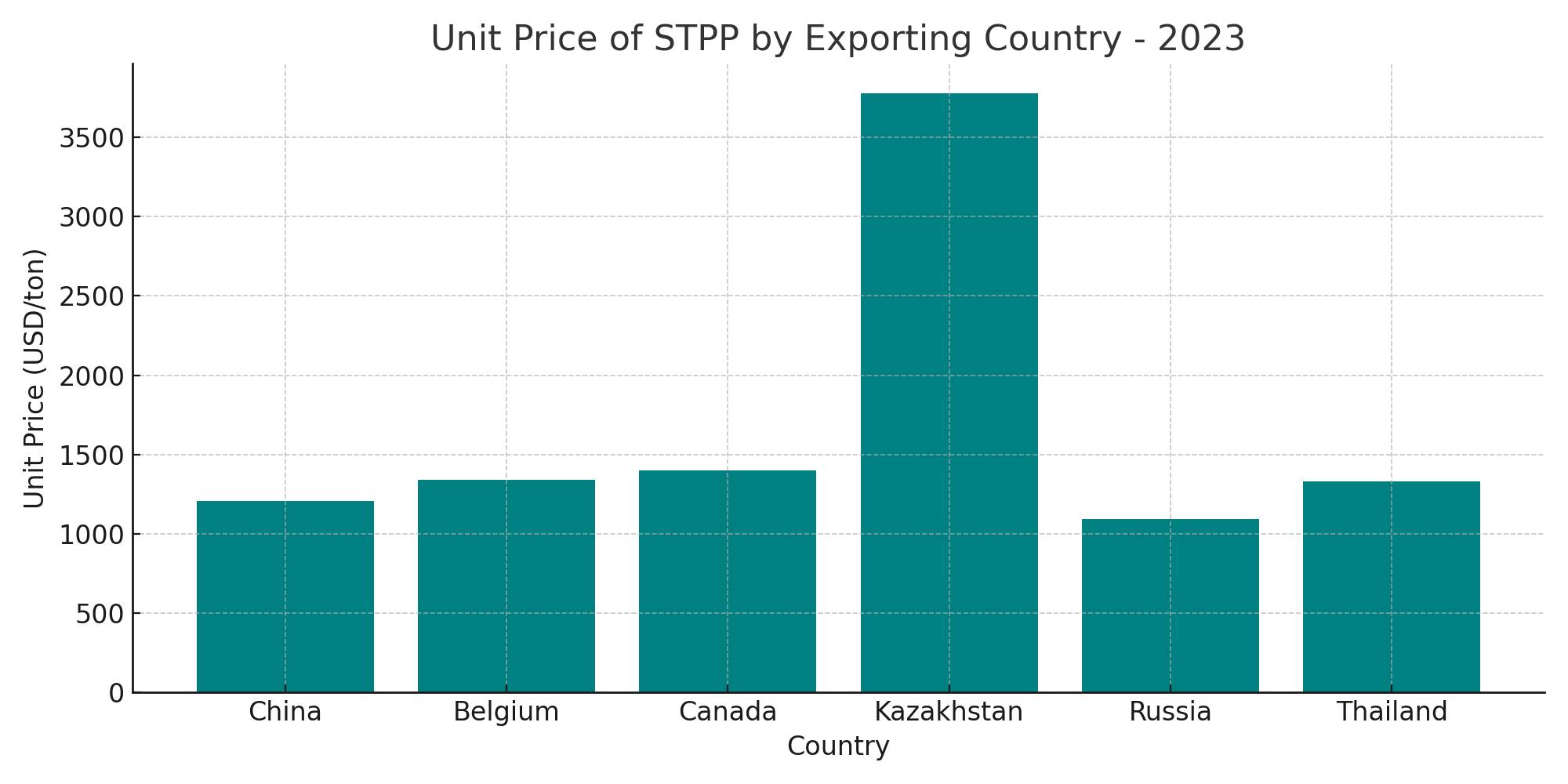
These disparities present both threats and opportunities. Countries with access to raw materials and regional proximity, such as those in the Middle East, can fill mid-range pricing gaps with consistent quality and flexible delivery terms.
Detailed Comparison of Export Unit Prices
While China remains the price leader at $1205/ton, other exporters show considerable variation. Kazakhstan tops the range with a staggering $3778/ton, which may reflect high production costs or specialized STPP grades.
Belgium and Russia occupy the mid-tier, pricing at approximately $1680/ton and $1430/ton respectively. These exporters often serve specific regional markets in Europe and Central Asia where brand reliability and logistics outweigh price alone.
Canada and Thailand are also noteworthy, maintaining average prices of $1590/ton and $1520/ton. Their unit prices suggest a focus on quality consistency and targeted industrial clients rather than aggressive price competition.
This range of export prices highlights the market’s segmented nature—with suppliers targeting different priorities, from bulk affordability to high-margin specialty products.
Leading Import Markets
India stands as the world’s largest importer of STPP, with an import value exceeding $61 million in 2023. This demand is largely driven by India’s expanding detergent and ceramic industries, which require high volumes of STPP for formulation and processing.
Other key importers include the United Arab Emirates (UAE), Syria, Turkey, Iraq, and Kenya. Each of these countries presents distinct logistical, economic, and geopolitical dynamics that shape trade patterns and supplier strategies.
For example, countries like Syria and Iraq face constraints related to infrastructure and payment systems. However, their demand for essential chemical inputs remains high, creating space for regional exporters with faster delivery capabilities and flexible payment terms.
Exporters located in or near the Middle East—such as Iran—can capitalize on this proximity by offering shorter lead times, lower logistics costs, and competitive pricing.
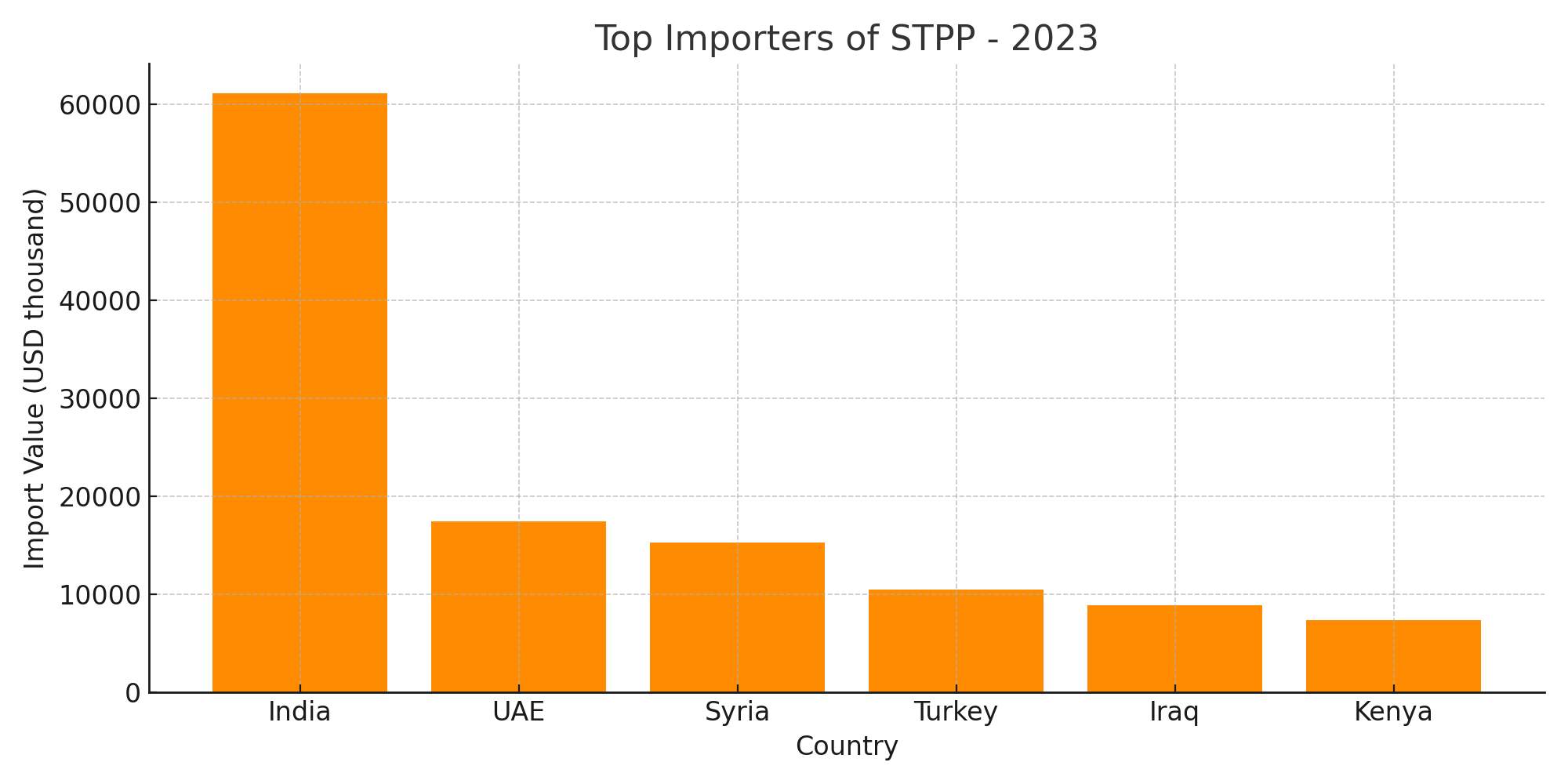
Strategically located exporters with trade links to these regions can benefit from this growing demand, especially where speed of delivery and price sensitivity are major factors.
Strategic Positioning: Russia’s Dual Role
Russia occupies a unique position in the global STPP trade. While it exported nearly $28 million worth of STPP in 2023, it also imported substantial volumes—primarily from China and Kazakhstan.
This dual role indicates a diverse domestic demand, with certain industries possibly requiring STPP grades or volumes that local production cannot fulfill efficiently or economically.
For mid-tier exporters, especially those in geographically closer regions, this presents a significant opportunity to tap into underserved or niche demand segments within Russia’s domestic market.
Establishing direct supply agreements or working through regional distributors could allow exporters to penetrate specific Russian industries with tailored offerings that balance price and performance.
Growth Trends and Market Potential
Between 2019 and 2023, global STPP trade saw notable volatility and regional realignment. While China continued to dominate the market, supply chain disruptions and post-pandemic recovery led to increased sourcing from alternative producers.
Smaller exporters in regions like South Asia, Eastern Europe, and the Middle East began to see more traction due to regional proximity, faster logistics, and greater pricing flexibility.
The ongoing industrial recovery in South and West Asia—particularly in countries like India, Turkey, and the UAE—is expected to drive further demand for STPP over the coming years.
Exporters aiming to grow in these regions should prioritize long-term supply relationships, technical documentation, and active participation in regional B2B platforms and expos.
Iran’s Export Performance and Strategic Outlook
In 2023, Iran exported approximately $3.2 million worth of STPP. India was the top buyer, accounting for $1.5 million (46%), followed by the UAE ($913k), Syria ($503k), and Turkey ($213k).
Though Iran holds a modest 0.5% share in global exports, its strong regional trade ties and proximity advantages provide significant room for growth. The country can position itself as a reliable supplier for neighboring markets with high STPP consumption.
With an average unit price of around $866/ton, Iranian STPP is highly competitive. However, scaling exports will require improvements in quality assurance, modern packaging, and B2B engagement.
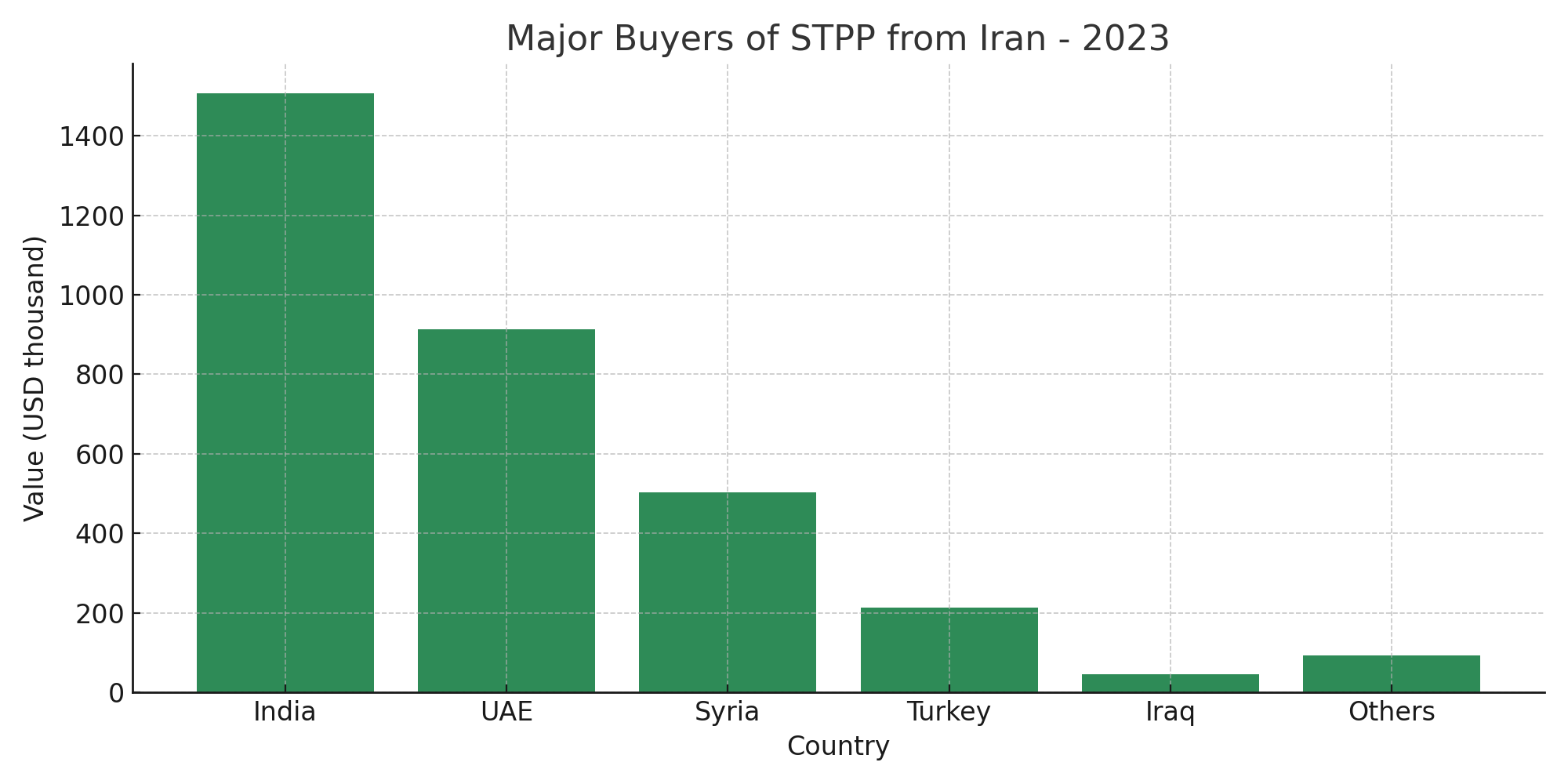
The average unit price of Iranian STPP (~$866/ton) is highly competitive compared to global players. To scale, Iran should focus on quality consistency, modern packaging, and stronger B2B outreach.
Opportunities for Iran
- Competitive pricing in price-sensitive markets across the Middle East and South Asia
- Established trade links with neighboring countries such as the UAE, Syria, and Turkey
- Low logistics costs due to geographic proximity
Challenges Facing Iranian Exporters
- Limited global brand recognition for Iranian chemical products
- Intense price competition from dominant players such as China
- Trade restrictions and payment risks in select international markets
Recommendations for Growth
To increase its market share in global STPP trade, Iran should:
- Expand into medium-potential regions such as Turkey, East Africa, and Central Asia
- Develop direct partnerships with industrial clients or offer long-term supply contracts
- Improve technical transparency through documentation and specifications
- Participate actively in industry expos and B2B platforms to build visibility and trust
Conclusion
The global STPP market remains strong, driven by industrial demand in Asia and the Middle East. While China maintains its dominance, exporters like Iran can gain ground by focusing on under-supplied, price-sensitive regions.
A regionally targeted, professionally marketed, and technically supported strategy will be essential for Iran to enhance its footprint in the international STPP trade landscape.
Interested in sourcing STPP or connecting with reliable Iranian producers? Contact us today for product specs, pricing, and tailored supply solutions.



